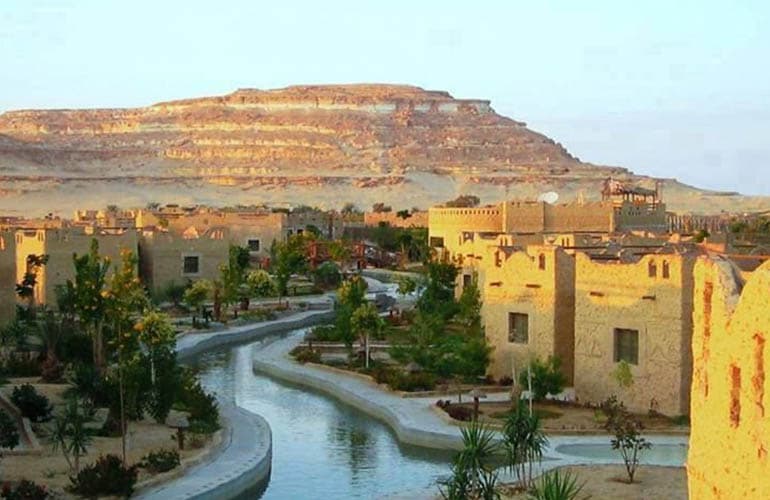Siwa Oasis Facts:

Siwa Oasis seems to spring out of nowhere, its lush, green orchards glistening like a mirage in the surrounding barren and inhospitable desert. More than 300 freshwater springs and streams sustain this remote desert oasis, feeding 300,000 date palms and 70,000 olive trees.
Huge saltwater lakes add to the spectacular scenery. Isolated on the edge of the Great Sand Sea, Siwa remained unchanged and largely unvisited for centuries. Roads now link Siwa to Marsa Matrouh on the Mediterranean coast and to Bahariyya Oasis in the southeast, bringing an influx of tourists to the area.
The ruins of the ancient mudbrick town of Shali tower above modern Siwa’s main square. Built-in 1203 to house the 40 survivors of a tribal attack on the nearby settlement of Aghurmi, this walled, hilltop town protected the entire Siwan population for centuries. Though the houses were abandoned in 1926 after heavy rain, the steep maze of streets can still be explored.
Close to Siwa’s town center, the House of Siwa Museum displays a collection of typical Siwan clothing, jewelry and handicrafts. The museum was the brainchild of a Canadian ambassador who feared the threat posed by tourism to Siwa’s traditional way of life.
A short distance north of the town, the limestone Mountain of the Dead, or Jebel al-Mawta, is riddled with tombs from the 26th Dynasty and Ptolemaic era. When fighting spread to Siwa during World War II, the Siwans sheltered in the tombs from bombing attacks. The 3rd-century BC Tomb of Si-Amun contains scenes depicting the deceased – a Siwan of Greek origins -with his family and the gods.
About 3 km (2 miles) east of Siwa, the Temple of the Oracle, built between 663 and 525 BC, stands on a rock that was once at the heart of the ancient settlement of Aghurmi. The Oracle’s fame was widespread and Alexander the Great came here to consult it in 332 BC after liberating Egypt from Persian rule.
Though the temple currently lies largely in ruins, the steep climb to the top is worthwhile for the stunning views it affords over the palm trees and lakes below.
Further east, all that remains of the huge 30th-Dynasty Temple of Amun is a wall decorated with bas-reliefs and a large pile of rubble. The temple was probably built by Nectanebo II during the 4th century BC.
A short distance away is Cleopatra’s Pool. Despite the name, Cleopatra never bathed here, but many people do venture into the circular pool for a swim, undeterred by algae floating on the surface of the water and onlookers watching from the busy path.
A better place for swimming can be found on Fatnis Island (also known as Fantasy Island), on the salt lake Birket Siwa, 6 km (4 miles) west of the town. A narrow causeway leads to the island, which is covered in lush palm trees and has an idyllic, secluded, freshwater pool in the center. The island can be reached by bike or donkey cart from Siwa.
Book your Travel Package now to know more about Egypt history.






